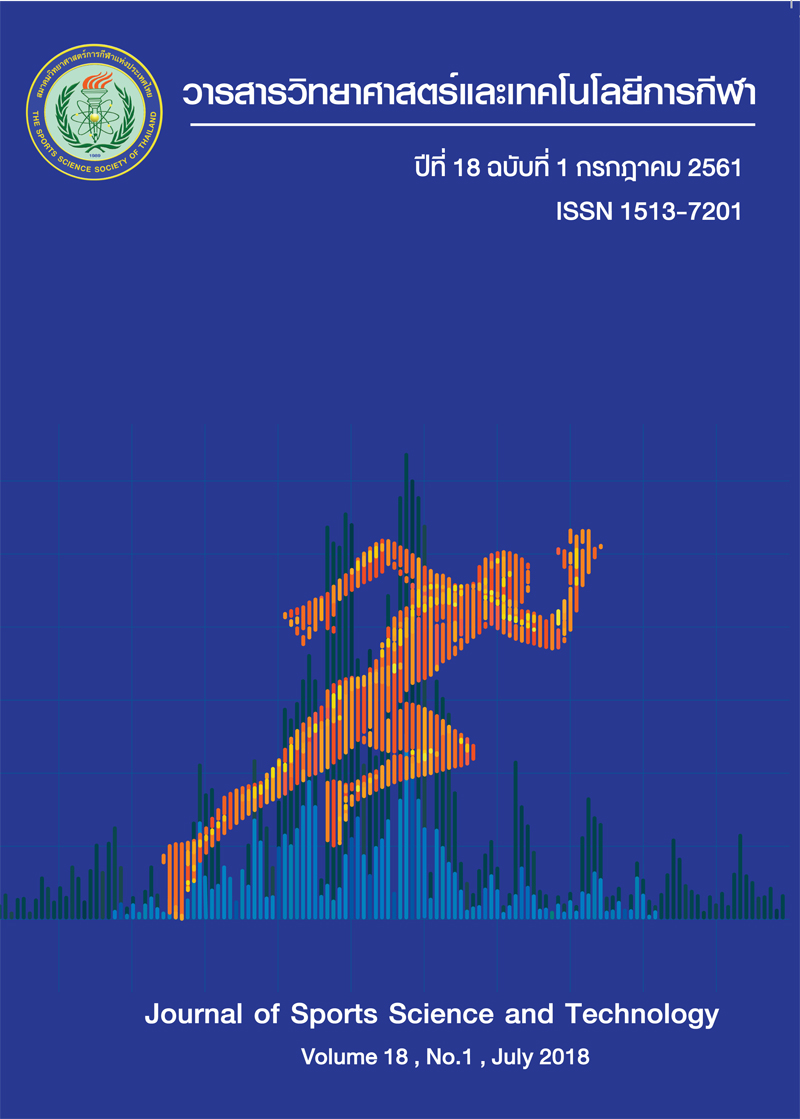การเปรียบเทียบอัตราการใช้ออกซิเจนระหว่างการทดสอบการออกกาลังกายแบบแกว่งแขนย่าเท้า อยู่กับที่และไม่แกว่งแขนย่าเท้าอยู่กับที่
คำสำคัญ:
อัตราการใช้ออกซิเจน / การออกกาลังกาย / การทดสอบออกกาลังกายแกว่งแขนย่าเท้าอยู่กับที่บทคัดย่อ
วัตถุประสงค์: เพื่อศึกษาเปรียบเทียบค่าอัตราการใช้ออกซิเจนระหว่างการทดสอบการออกกำลังกายแบบแกว่งแขนย่ำเท้าอยู่กับที่และไม่แกว่งแขนย่ำเท้าอยู่กับที่ วิธีดำเนินการวิจัย: การวิจัยเชิงปริมาณ แบบสุ่มไขว้ อาสาสมัครเพศชายสุขภาพดี (ค่าดัชนีมวลกายเฉลี่ย 22.4 ± 1.2 กิโลกรัมต่อตารางเมตร) อายุ 20-25 ปี จำนวน 11 คน อาสาสมัครทั้งหมดได้รับการทดสอบการออกกำลังกายด้วยการแกว่งแขนย่ำเท้าอยู่กับที่และไม่แกว่งแขนย่ำเท้าอยู่กับที่ โดยการสุ่มคอมพิวเตอร์เรียงลำดับก่อนหลัง อาสาสมัครทั้งหมดถูกวัดอัตราการใช้ออกซิเจนขณะการทดสอบออกกำลังกายเป็นระยะเวลา 6 นาที ด้วยเครื่องวิเคราะห์ก๊าซผ่านทางลมหายใจ ทำการทดสอบห่างกันอย่างน้อย 24 ชั่วโมง ข้อมูลทั้งหมดถูกวิเคราะห์ด้วยสถิติเทียบรายคู่ (Paired t-test) กำหนดค่านัยสำคัญทางสถิติที่ 0.05 ผลการวิจัย: การทดสอบออกกำลังกายด้วยการแกว่งแขนย่ำเท้าอยู่กับที่มีค่าผลรวมอัตราการใช้ออกซิเจน (787.7 ± 108.9 ลิตร) และอัตราการใช้ออกซิเจนช่วงสุดท้ายของการทดสอบ (2.43 ± 0.09 ลิตรต่อนาที) มากกว่าการทดสอบการออกกำลังกายด้วยการไม่แกว่งแขนย่ำเท้าอยู่กับที่ (ค่าผลรวมอัตราการใช้ออกซิเจน เท่ากับ 717.6 ± 94.9 ลิตร และอัตราการใช้ออกซิเจนช่วงสุดท้ายของการทดสอบ เท่ากับ 2.29 ± 0.09 ลิตรต่อนาที) อย่างมีนัยสำคัญทางสถิติ (P = 0.001 และ 0.019 ตามลำดับ) สรุปผล: การทดสอบการออกกำลังกายแบบแกว่งแขนย่ำเท้าอยู่กับที่มีอัตราการใช้ออกซิเจนมากกว่าการทดสอบออกกำลังกายแบบไม่แกว่งแขนย่ำเท้าอยู่กับที่
วารสารวิทยาศาสตร์และเทคโนโลยีการกีฬา 2561; 18(1) : 16-26
เอกสารอ้างอิง
2. Kasikcioglu E, Toker A, Tanju S, Arzuman P, Kayserilioglu A, Dilege S, Kalayci G. Oxygen uptake kinetics during cardiopulmonary exercise testing and postoperative complications in patients with lung cancer. Lung Cancer. 2009 Oct 31;66(1):85-8.
3. Burnside WS, Snowden C. Physiological basis of preoperative cardiopulmonary exercise testing. Surgery (Oxford). 2014 Feb 28;32(2):59-62.
4. Asplund G. A submaximal test for arm ergometry to determine peak oxygen uptake rate in upper body exercise (Thesis). San Jose State University. 1995.
5. American College of Sports Medicine. ACSM's guidelines for exercise testing and prescription. Philadelphia: Lippincott Williams & Wilkins; 2013 Mar 4.
6. Eston RG, Brodie DA. Responses to arm and leg ergometry. Br J Sports Med. 1986 Mar 1;20(1):4-6.
7. Di Blasio A, Sablone A, Civino P, D’Angelo E, Gallina S, Ripari P. Arm vs. combined leg and arm exercise: blood pressure responses and ratings of perceived exertion at the same indirectly determined heart rate. J Sports Sci Med. 2009 Sep;8(3):401-409.
8. Polen ZK, Joshi S. Comparison of treadmill versus cycle ergometer training on functional exercise capacity in normal individuals. Int J Cur Res Rev. 2014 Oct 15;6(20):61-65.
9. Pongpanit K. Jones CU, Jones DA, Boonsawat W. Positive Expiratory Pressure Breathing Increases the Recovery of Dyspnea in Patients with COPD. Thai J Phys Ther. 2015;37(1):1-13.
10. Kaveephab W, Phimpasak C, Chaisuksan S, Jones C. A new cardiopulmonary exercise test for chronic obstructive pulmonary disease patients. Thai J Phys Ther. 2016; (1): 72-7.
11. Kerdjunteak S., et al. Physical fitness norm of Thai populations. Bangkok: New Thai Mirth Printing house; 2543.
12. Rattanawiwatpong P, Khunphasee A, Pongurgsorn C, Intarakamhang P. Validity and reliability of the Thai version of short format International Physical Activity Questionnaire (IPAQ). J Thai Rehabil. 2006; 16(3):147-60.
13. Shaikh ZA, Khatoon F, Nankani K, Kumar D. Yield of Screening for Blood Pressure of Employees in a Medical University at Karachi. Gomal J Med Sci. 2010; 8(2):156-160.
14. McArdle WD, Katch FI, Katch VL. Exercise physiology: nutrition, energy, and human performance: Lippincott Williams & Wilkins; 2010.
15. Roston WL, Whipp BJ, Davis JA, Cunningham DA, Effros RM, Wasserman K. Oxygen uptake kinetics and lactate concentration during exercise in humans. Am Rev Respir Dis. 1987; 135(5):1080-4.
16. Wiewelhove T, Fernandez-Fernandez J, Raeder C, Kappenstein J, Meyer T, Kellmann M, et al. Acute responses and muscle damage in different high-intensity interval running protocols. J Sports Med Phys Fitness. 2016; 56(5):606-15.
17. Mayo JJ, Kravitz L, Wongsathitkun J. Detecting the onset of added cardiovascular strain during combined arm and leg exercise. J Exerc Physiol Online. 2001 Aug 1;4(3):53-60.
18. Toner MM, Sawka MN, Levine LE, Pandolf KB. Cardiorespiratory responses to exercise distributed between the upper and lower body. J Appl Physiol. 1983 May 1;54(5):1403-7.
19. Hoffman MD, Kassay KM, Zeni AI, Clifford PS. Does the amount of exercising muscle alter the aerobic demand of dynamic exercise?. Eur J Appl Physiol Occup Physiol. 1996 Dec 1;74(6):541-7.
20. Powers S, Howley ET. Exercise physiology: Theory and application to fitness and performance. McGraw-Hill Higher Education; 2014.
21. Lewis SF, Taylor WF, Graham RM, Pettinger WA, Schutte JE, Blomqvist CG. Cardiovascular responses to exercise as functions of absolute and relative work load. J Appl Physiol. 1983 May 1;54(5):1314-23.
22. Astrand PO, Rodhal K. Textbook of Work Physiology. New York: McGraw Hill; 1997.
23. McCurdy T. Physiological parameters and physical activity data for evaluating exposure modeling performance: A synthesis. Washington: U.S. Environmental Protection Agency; 2015.
24. Cheng YJ, Macera CA, Addy CL, Sy FS, Wieland D, Blair SN. Effects of physical activity on exercise tests and respiratory function. Br J Sports Med. 2003 Dec 1;37(6):521-8.
25. Nagle FJ, Richie JP, Giese MD. VO2max responses in separate and combined arm and leg air-braked ergometer exercise. Med Sci Sports Exerc. 1984 Dec;16(6):563-6.
26. Verhoeff LL, Horlings CG, Janssen LJ, Bridenbaugh SA, Allum JH. Effects of biofeedback on trunk sway during dual tasking in the healthy young and elderly. Gait Posture. 2009 Jul 31;30(1):76-81.
27. Beauchet O, Dubost V, Herrmann FR, Kressig RW. Stride-to-stride variability while backward counting among healthy young adults. J Neuroeng Rehabil. 2005 Dec 1;2(1):26.






